How white dwarfs mimic black holes
New research has revealed that bright X-ray flares in nearby galaxies, once assumed to indicate the presence of black holes, can in fact be produced by white dwarfs.
Dec 17th, 2012
Read more
 Subscribe to our Space Exploration News feed
Subscribe to our Space Exploration News feed
New research has revealed that bright X-ray flares in nearby galaxies, once assumed to indicate the presence of black holes, can in fact be produced by white dwarfs.
Dec 17th, 2012
Read more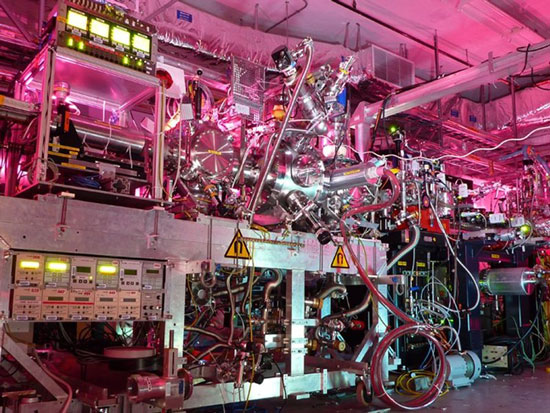 A precision experiment has provided details of the X-ray emissions from highly ionised iron, advancing our understanding of black holes and supernovae.
A precision experiment has provided details of the X-ray emissions from highly ionised iron, advancing our understanding of black holes and supernovae.
Dec 16th, 2012
Read more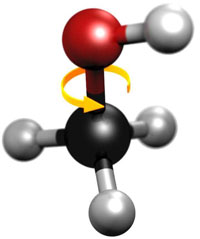 Fundamental properties of molecules have not changed during the past seven billion years.
Fundamental properties of molecules have not changed during the past seven billion years.
Dec 14th, 2012
Read more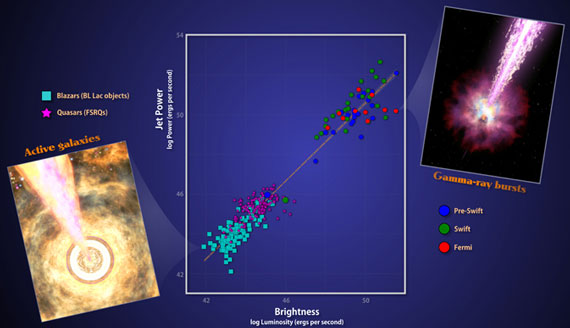 A new study using data from NASA's Swift satellite and Fermi Gamma-ray Space Telescope shows that high-speed jets launched from active black holes possess fundamental similarities regardless of mass, age or environment. The result provides a tantalizing hint that common physical processes are at work.
A new study using data from NASA's Swift satellite and Fermi Gamma-ray Space Telescope shows that high-speed jets launched from active black holes possess fundamental similarities regardless of mass, age or environment. The result provides a tantalizing hint that common physical processes are at work.
Dec 13th, 2012
Read more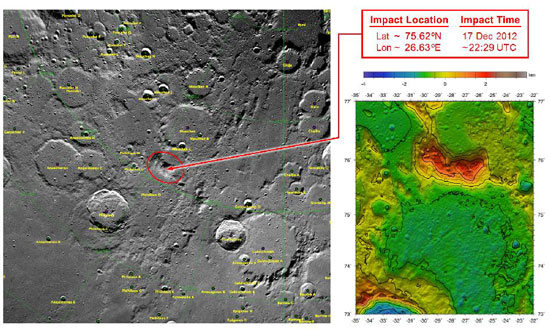 Twin lunar-orbiting NASA spacecraft that have allowed scientists to learn more about the internal structure and composition of the moon are being prepared for their controlled descent and impact on a mountain near the moon's north pole at about 5:28 p.m. EST Monday, Dec. 17.
Twin lunar-orbiting NASA spacecraft that have allowed scientists to learn more about the internal structure and composition of the moon are being prepared for their controlled descent and impact on a mountain near the moon's north pole at about 5:28 p.m. EST Monday, Dec. 17.
Dec 13th, 2012
Read more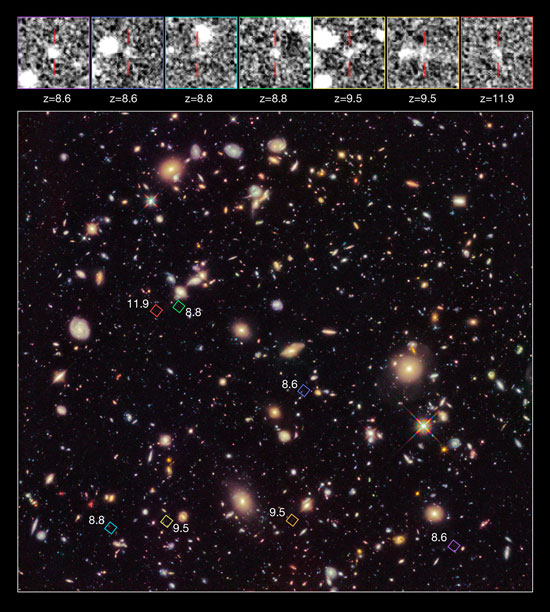 Astronomers using the NASA/ESA Hubble Space Telescope have uncovered seven primitive galaxies from a distant population that formed more than 13 billion years ago.
Astronomers using the NASA/ESA Hubble Space Telescope have uncovered seven primitive galaxies from a distant population that formed more than 13 billion years ago.
Dec 13th, 2012
Read more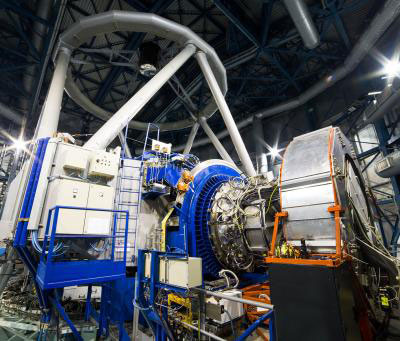 The K-band Multi-Object Spectrograph (KMOS), attached to the Very Large Telescope (VLT) Unit Telescope 1 at ESO's Paranal Observatory in Chile, has successfully achieved first light.
The K-band Multi-Object Spectrograph (KMOS), attached to the Very Large Telescope (VLT) Unit Telescope 1 at ESO's Paranal Observatory in Chile, has successfully achieved first light.
Dec 12th, 2012
Read more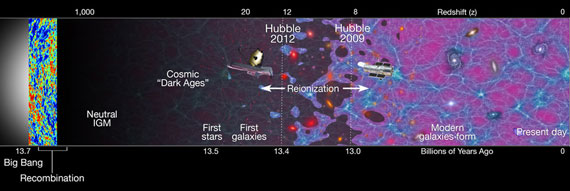 A team of astronomers led by the California Institute of Technology (Caltech) has used NASA's Hubble Space Telescope to discover seven of the most primitive and distant galaxies ever seen.
A team of astronomers led by the California Institute of Technology (Caltech) has used NASA's Hubble Space Telescope to discover seven of the most primitive and distant galaxies ever seen.
Dec 12th, 2012
Read more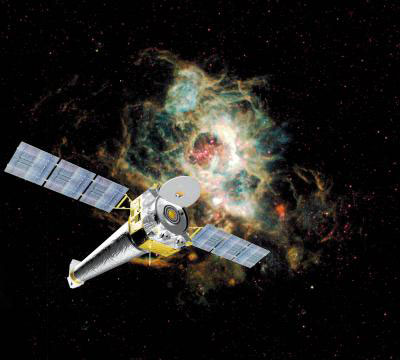 Scientists have used powerful X-rays from the Linac Coherent Light Source (LCLS) at the U.S. Department of Energy's (DOE) SLAC National Accelerator Laboratory, to study and measure, in atomic detail, a key process at work in extreme plasmas like those found in stars, the rims of black holes and other massive cosmic phenomena.
Scientists have used powerful X-rays from the Linac Coherent Light Source (LCLS) at the U.S. Department of Energy's (DOE) SLAC National Accelerator Laboratory, to study and measure, in atomic detail, a key process at work in extreme plasmas like those found in stars, the rims of black holes and other massive cosmic phenomena.
Dec 12th, 2012
Read more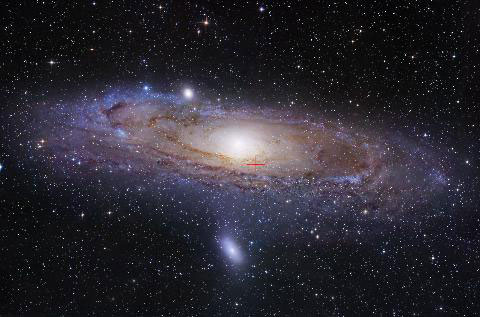 Object is first of its type found beyond our own Milky Way.
Object is first of its type found beyond our own Milky Way.
Dec 12th, 2012
Read more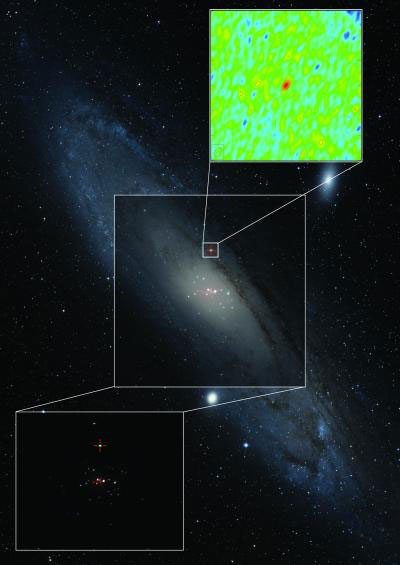 The discovery of a bingeing black hole that is expelling powerful beams of material has shed new light on some of the brightest X-ray sources seen in other galaxies, according to new research led by Durham University.
The discovery of a bingeing black hole that is expelling powerful beams of material has shed new light on some of the brightest X-ray sources seen in other galaxies, according to new research led by Durham University.
Dec 12th, 2012
Read moreA new data analysis tool will be used by researchers of the ARC Centre of Excellence for All-sky Astrophysics (CAASTRO) at Curtin University to handle large quantities of data coming in from the new low frequency radio telescope, the Murchison Widefield Array (MWA).
Dec 12th, 2012
Read more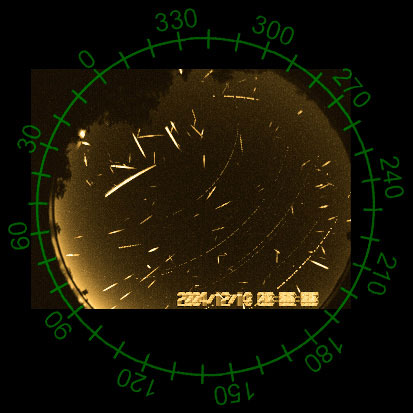 On the evening of 13 and the morning of 14 December, skywatchers across the world will be looking up as the Geminid meteor shower reaches its peak, in potentially one of the best night sky events of the year.
On the evening of 13 and the morning of 14 December, skywatchers across the world will be looking up as the Geminid meteor shower reaches its peak, in potentially one of the best night sky events of the year.
Dec 12th, 2012
Read more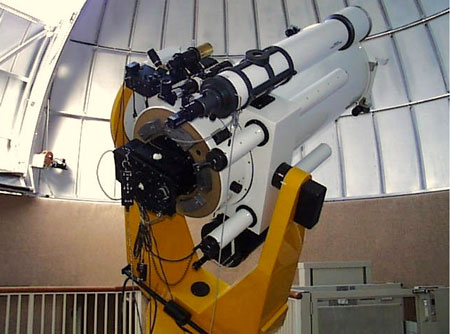 An asteroid that some day might threaten Earth is passing relatively close by on the night of December 11-12, and its gliding path among the stars will be tracked by a team of high-school students at the Clay Center Observatory in Brookline, Massachusetts.
An asteroid that some day might threaten Earth is passing relatively close by on the night of December 11-12, and its gliding path among the stars will be tracked by a team of high-school students at the Clay Center Observatory in Brookline, Massachusetts.
Dec 11th, 2012
Read more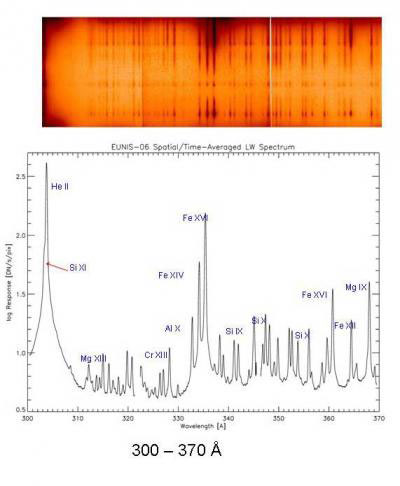 In December, a NASA mission to study the sun will make its third launch into space for a six-minute flight to gather information about the way material roils through the sun's atmosphere, sometimes causing eruptions and ejections that travel as far as Earth.
In December, a NASA mission to study the sun will make its third launch into space for a six-minute flight to gather information about the way material roils through the sun's atmosphere, sometimes causing eruptions and ejections that travel as far as Earth.
Dec 11th, 2012
Read moreVega, a star astronomers have used as a touchstone to measure other stars' brightness for thousands of years, may be more than 200 million years older than previously thought.
Dec 11th, 2012
Read more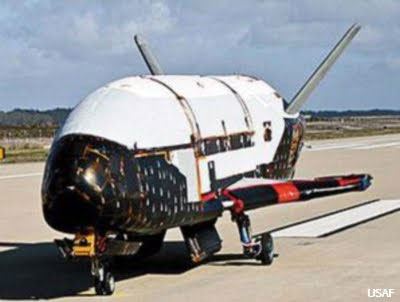 A top-secret mini-space shuttle has blasted off from Cape Canaveral.
A top-secret mini-space shuttle has blasted off from Cape Canaveral.
Dec 11th, 2012
Read more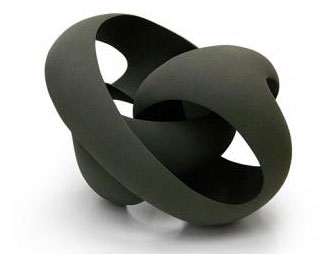 Black holes are surrounded by many mysteries, but now researchers from the Niels Bohr Institute, among others, have come up with new groundbreaking theories that can explain several of their properties. The research shows that black holes have properties that resemble the dynamics of both solids and liquids.
Black holes are surrounded by many mysteries, but now researchers from the Niels Bohr Institute, among others, have come up with new groundbreaking theories that can explain several of their properties. The research shows that black holes have properties that resemble the dynamics of both solids and liquids.
Dec 11th, 2012
Read more